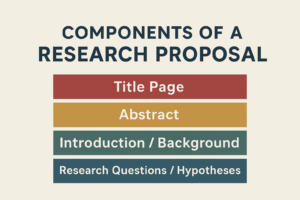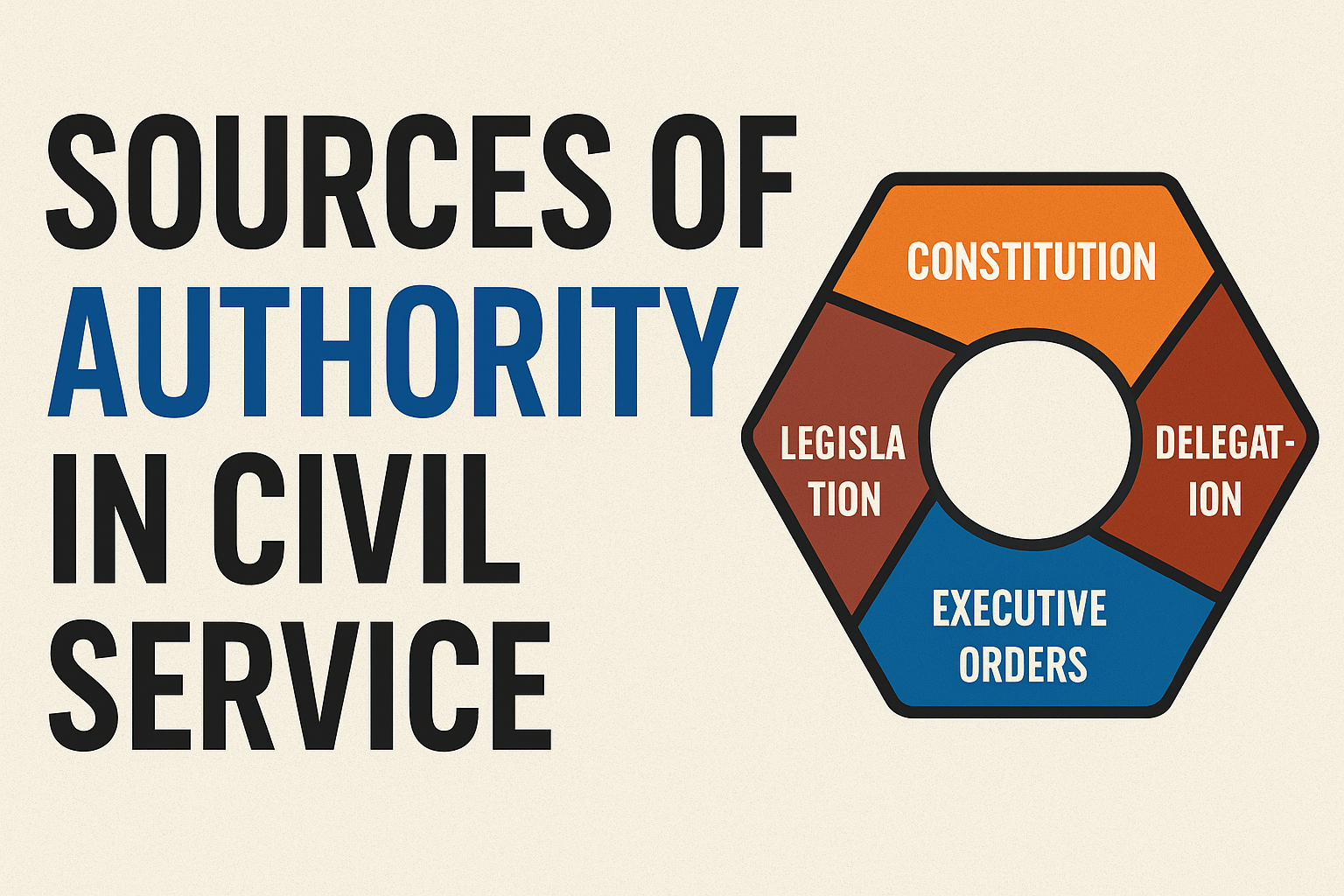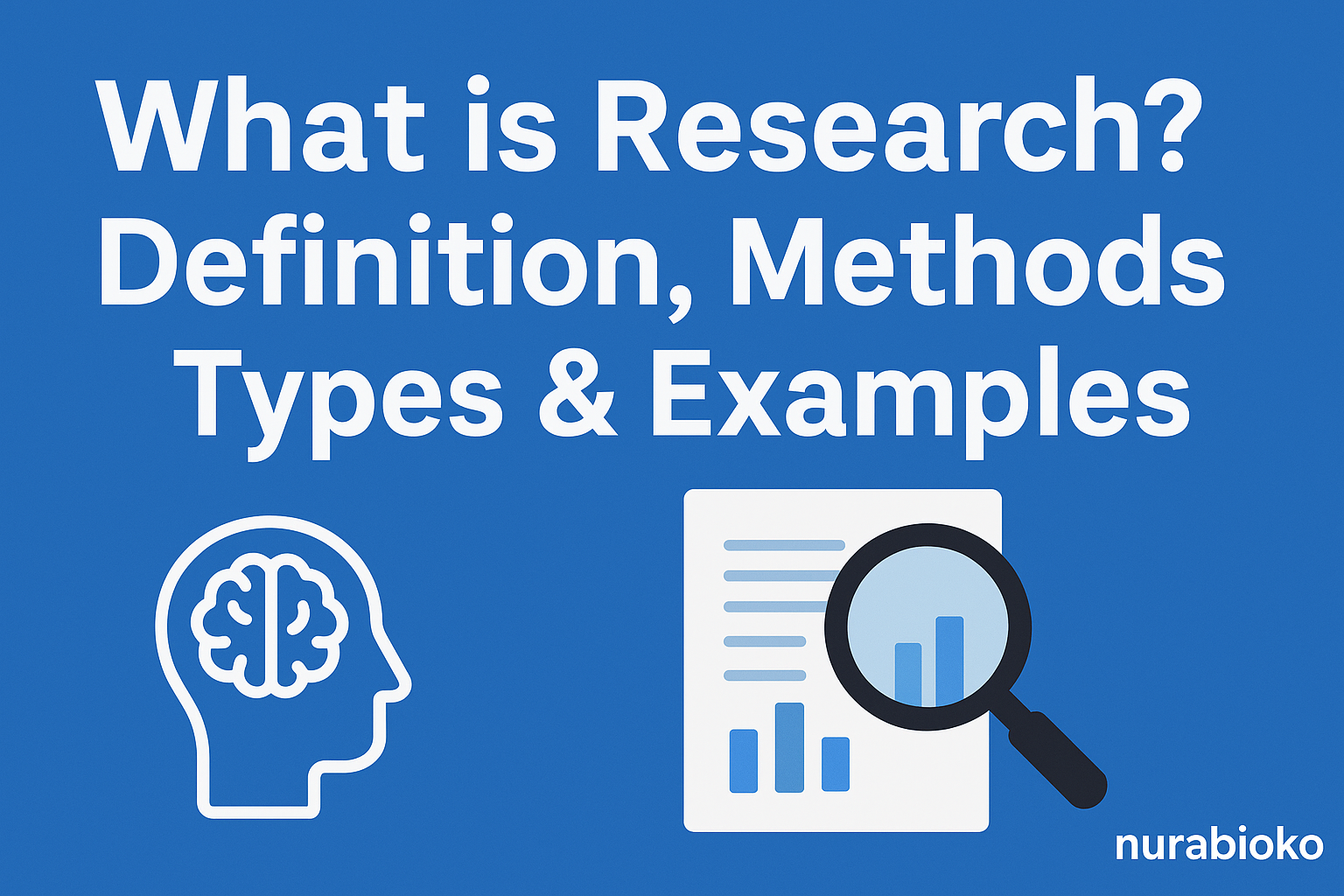
Introduction: Understanding What a Research Proposal Really Is
Before any research begins, you need a plan — and that plan is called a research proposal.
Think of it as a blueprint that explains what you want to study, why it matters, and how you plan to do it. Whether you’re a student writing your first project or an online learner preparing for academic research, your proposal is the foundation of your entire study.
In simple terms, a research proposal is:
“A written plan that outlines what you intend to research, how you’ll do it, and why it’s important.”
It helps convince your supervisor, professor, or funding body that your idea is relevant, realistic, and valuable.
But what makes up a good research proposal?
Let’s explore all the main components of a research proposal and how to write each one step by step.
1. Title Page
Your title page is the first thing anyone sees — it sets the tone for your proposal. It provides essential details about your research and identifies you as the researcher.
A good title page usually includes:
- The research title (clear and descriptive)
- Your name and matriculation number
- Your institution, department, and faculty
- The course or degree program
- Your supervisor’s name (if applicable)
- The date of submission
Example:
The Impact of Social Media Usage on Academic Performance among Undergraduate Students in Nigeria
Tip: Keep your title short (under 15 words), specific, and easy to understand. Avoid vague terms like “A Study of Things Affecting Students.” Be precise and focused.
2. Abstract
The abstract is a summary of your entire research proposal — usually between 150 to 250 words.
It tells readers:
- What your study is about
- Why are you doing it
- How do you plan to carry it out
- What you expect to find
Although it appears first, it’s often written last — after you’ve developed the full proposal.
Example Abstract:
This study explores the impact of social media on academic performance among Nigerian university students. The research aims to identify how the use of platforms like WhatsApp, Facebook, and TikTok affects students’ study habits, focus, and overall grades. Using a descriptive survey design, data will be collected from 200 students across three universities. Findings from this study will help develop strategies for balancing social media usage and academic productivity.
Abstract of a research proposal: what is abstract in research
3. Introduction or Background of the Study
This is where your proposal truly begins. The introduction provides the context and background for your topic. It explains the problem you’re studying and why it matters.
In this section, you should:
- Introduce your topic clearly
- Provide background information
- Explain the problem or situation your research addresses
- Justify why the research is important
Example:
Over the past decade, social media has become a central part of student life. While it has improved communication and access to learning materials, excessive use can also lead to distractions and poor academic performance. Understanding this balance is essential for improving education outcomes.
Tip: Use statistics, real-life examples, or brief case studies to make your background more engaging and credible.
Background of the study, research proposal introduction, how to write the background of the study
4. Statement of the Problem
Your problem statement is the heart of your proposal. It defines exactly what problem your research will solve.
Ask yourself:
- What issue exists that needs attention?
- Why is it important to solve this problem now?
- What gap exists in previous research?
Example:
Despite the growing popularity of social media, there is limited research on how it affects students’ learning behaviors in Nigerian universities. This knowledge gap has made it difficult for educators to design effective interventions.
Tips for Writing a Strong Problem Statement:
✅ Be specific and focused.
✅ Avoid vague or general issues.
✅ Make sure the problem is researchable.
statement of the problem in research, how to write a research problem, examples of research problems
5. Research Questions or Hypotheses
Every research starts with questions — and those questions come from your problem statement.
Research questions guide your entire study. They help you stay focused and organized.
Example Research Questions:
- What types of social media platforms are most commonly used by students?
- How does social media usage affect students’ study habits?
- Is there a relationship between social media usage and academic performance?
For quantitative studies, you may also include hypotheses — statements predicting what you expect to find.
Example Hypothesis:
- H₁: There is a significant relationship between the frequency of social media use and students’ academic performance.
research questions examples, hypothesis in research, difference between research question and hypothesis
6. Objectives of the Study
The objectives define what you hope to achieve through your research.
They are usually divided into:
- General Objective (Main aim)
- Specific Objectives (Smaller goals)
Example:
General Objective:
To investigate the impact of social media on academic performance among university students.
Specific Objectives:
- To determine the most used social media platforms among students.
- To examine the relationship between time spent on social media and study habits.
- To identify strategies students use to balance social media use and studies.
Objectives of a research proposal, how to write research objectives
7. Literature Review
The literature review is your chance to show that you’ve done your homework.
It involves reviewing previous studies, theories, and ideas related to your topic. The goal is to identify what has already been done — and what gaps still exist.
Steps to Write a Good Literature Review:
- Search for credible academic sources (journals, textbooks, government publications).
- Summarize what others have discovered.
- Identify the gap your study will fill.
- End with a conceptual or theoretical framework (optional but recommended).
Example:
Several studies (Adebayo, 2020; Musa, 2021) found that social media use influences students’ academic performance. However, most focused on Western countries, leaving limited data on Nigerian university students.
Literature review in research, how to write a literature review, purpose of literature review
8. Research Methodology
This section answers the how of your study. It describes how you plan to collect and analyze data.
Key elements of methodology:
- Research design: Qualitative, quantitative, or mixed methods.
- Population: Who you’re studying (e.g., students, teachers, workers).
- Sample size: Number of participants.
- Sampling technique: Random, stratified, purposive, etc.
- Data collection methods include questionnaires, interviews, and observation.
- Data analysis: How data will be processed (SPSS, thematic analysis, etc.)
- Ethical considerations: Confidentiality, consent, honesty.
Example:
This study will adopt a descriptive survey design. Data will be collected using questionnaires distributed to 200 university students across three campuses. Data will be analyzed using simple percentages and correlation tests.
research methodology example, components of research methodology, data collection methods
9. Significance of the Study
Why does your research matter? That’s what this section answers.
It explains:
- Who will benefit from your findings (students, teachers, policymakers, etc.)
- How your research contributes to knowledge
- The practical or theoretical importance of the study
Example:
This study will provide useful insights for educators and policymakers on how to manage the effects of social media on learning. It will also help students develop healthier online habits.
significance of the study, importance of research proposal
10. Scope and Limitations of the Study
This section defines the boundaries of your research — what you’ll cover and what you won’t.
- Scope: The extent of your study (area, population, time frame).
- Limitations: Challenges or constraints that might affect your results (budget, time, data access).
Example:
This study focuses only on undergraduate students in three selected Nigerian universities. It does not include postgraduate or secondary school students.
scope and limitations examples, delimitations in research
11. Work Plan or Time Frame
A strong proposal shows that you’ve thought through your timeline.
You can present it as a table or a Gantt chart.
Example Table:
| Activity | Duration |
|---|---|
| Literature Review | 2 weeks |
| Questionnaire Design | 1 week |
| Data Collection | 3 weeks |
| Data Analysis | 2 weeks |
| Report Writing | 4 weeks |
Tip: Ensure your schedule is realistic and aligns with your academic calendar or project deadlines.
work plan in research proposal, research timeline example
12. Budget or Estimated Cost
If you’re applying for funding or support, include a budget that outlines your estimated expenses.
Typical budget items include:
- Printing and stationery
- Transportation
- Data collection materials (e.g., questionnaires)
- Software and internet costs
- Report binding and documentation
Example Table:
| Item | Estimated Cost (₦) |
|---|---|
| Printing and Photocopying | 10,000 |
| Transportation | 8,000 |
| Data Analysis Tools | 5,000 |
| Report Binding | 3,000 |
| Total | ₦26,000 |
research proposal budget, sample research budget
13. References or Bibliography
Every research proposal must list the sources you used (references in research proposal). This builds credibility and helps avoid plagiarism.
Use a consistent citation style, such as:
- APA (American Psychological Association)
- MLA (Modern Language Association)
- Chicago Style
Example (APA reference examples):
Adebayo, K. (2020). Social Media and Student Performance. Lagos: Academic Press
14. Appendices
The appendix (or appendices) in a research proposal includes all the supporting materials that are too detailed for the main text.
An example of an appendix might include:
- Sample questionnaires or interview questions
- Tables or figures
- Ethical approval forms
- Letters of consent
Summary Table: Key Components of a Research Proposal
| Section | Purpose |
|---|---|
| Title Page | Identifies your topic and researcher details |
| Abstract | Summarizes the proposal |
| Introduction | Provides background and context |
| Problem Statement | Defines the issue |
| Research Questions/Hypotheses | Direct the study |
| Objectives | Outline what to achieve |
| Literature Review | Summarizes past studies |
| Methodology | Explains how research will be conducted |
| Significance | Shows importance and contribution |
| Scope & Limitations | Defines boundaries |
| Work Plan | Outlines timeline |
| Budget | Lists estimated costs |
| References | Cites sources used |
| Appendices | Adds extra materials |
FAQs — People Also Search For
1. What are the main components of a research proposal?
A research proposal is made up of several key components that work together to communicate your study idea effectively. The main parts include the title page, abstract, introduction, problem statement, research questions or hypotheses, objectives, literature review, methodology, significance of the study, scope and limitations, work plan, budget, references, and appendices. Each section serves a distinct purpose — from defining your topic to explaining how you’ll conduct your research. When combined, these components create a logical, well-organized document that helps your readers understand what you plan to do and why your research is worth conducting.
2. What is the most important part of a research proposal?
While every section of a research proposal matters, most experts agree that the problem statement and research methodology are the most critical. The problem statement highlights why your study is necessary — it defines the issue or knowledge gap that your research will address. The methodology, on the other hand, explains how you intend to solve that problem through data collection and analysis. Without these two core components, your proposal lacks direction and credibility. A clear, well-defined problem combined with a strong, realistic methodology can convince reviewers that your research is both valuable and achievable.
3. How many pages should a research proposal be?
The length of a research proposal depends on your academic level and institutional guidelines, but it generally ranges from 5 to 10 pages for undergraduate or master’s studies and up to 15–25 pages for Ph.D. or funded research. The most important thing is not the number of pages but the quality and clarity of your content. Each section should be detailed enough to show understanding but concise enough to keep your reader engaged. Avoid padding your proposal with unnecessary information — focus on presenting a strong argument that is easy to follow, well-organized, and aligned with your research objectives.
4. What makes a good research proposal?
A good research proposal is one that clearly communicates your idea, relevance, and approach in a structured and persuasive way. It should demonstrate that you have a sound understanding of the topic, a realistic plan for carrying out the study, and that your work will add something new to existing knowledge. Good proposals are also well-written, free from grammatical errors, and formatted according to academic standards. Remember to provide evidence that your study is feasible, both in terms of resources and time. Above all, a great research proposal answers three key questions: What are you studying? Why does it matter? How will you do it?
5. Is an abstract necessary in a proposal?
Yes — the abstract is an essential part of every research proposal. It serves as a short, powerful summary that allows readers, supervisors, or reviewers to quickly grasp the core of your study without reading the entire document. A well-written abstract (about 150–250 words) should briefly mention your research topic, objectives, methodology, and expected outcome. Think of it as your proposal’s elevator pitch — it’s often the first section reviewers read, and a strong abstract can make a lasting first impression. Even though it appears at the beginning of your proposal, it’s usually written last, after all the other sections are complete.
6. What is the difference between a research proposal and a research report?
The main difference lies in timing and purpose. A research proposal is written before the research begins — it outlines what you plan to study, how you’ll do it, and why it matters. It’s meant to convince others (like your supervisor or funding body) that your research idea is worth pursuing. A research report, on the other hand, is written after the study has been completed. It presents your findings, data analysis, and conclusions. In short, a proposal is a plan of action, while a report is the final result of that action. Both documents are essential, but they serve very different stages of the research process.
7. Can I write a research proposal without prior experience?
Absolutely! Many students and beginners successfully write their first research proposals with no prior experience. The key is to follow a clear structure and take it step by step. Start by choosing a topic that genuinely interests you, then narrow it down to a specific, researchable problem. Read similar studies to learn how professionals structure their proposals. You can also use guides like this one or seek advice from your supervisor. Remember — clarity is more important than complexity. Even without experience, a well-organized, simple, and sincere proposal can impress your reviewers and earn approval.
8. How do I choose a good research topic?
Choosing the right research topic is one of the most important steps in writing a proposal. A good topic should be specific, relevant, and researchable. Start by brainstorming areas that genuinely interest you — it’s easier to stay motivated when you care about the subject. Then, check if enough existing literature or data is available to support your work. Avoid topics that are too broad or vague; instead, focus on a clearly defined issue that can be studied within your time and resource limits. Also, discuss your topic idea with your supervisor to ensure it’s suitable for your field of study.
9. Why do researchers prepare research proposals before conducting a study?
Researchers prepare research proposals because they serve as a roadmap for the entire study. The proposal helps define the problem, outline objectives, and specify the methods to be used. It ensures that the researcher stays focused, organized, and systematic throughout the process. More importantly, proposals are often required for approval or funding — they help convince academic supervisors, ethics committees, or sponsors that your project is worthwhile and achievable. Without a proposal, your research might lack structure or fail to meet ethical and academic standards. In essence, the proposal is the planning stage that sets the foundation for a successful research journey.
10. Can a research proposal be rejected?
Yes, a research proposal can be rejected — but that’s not always a bad thing. Proposals are sometimes turned down because they lack clarity, have weak problem statements, unrealistic objectives, or poor methodology. In other cases, the topic may not align with the institution’s priorities or ethical standards. However, rejection is often part of the learning process. Most successful researchers experience it at some point. The best approach is to treat feedback as an opportunity to improve. Revise your proposal based on the reviewers’ comments, strengthen your arguments, and resubmit. Persistence, clarity, and attention to detail usually lead to approval.
Conclusion
A research proposal is more than just a formal academic document — it’s a roadmap that transforms your research idea into a clear, actionable plan. Understanding its key components helps you communicate your ideas confidently and professionally, whether you’re a student preparing your first project or a researcher pitching for funding. Each section — from the title and introduction to the methodology and references — serves a unique purpose in convincing readers that your study is worth pursuing.
A well-structured proposal shows that you’re organized, knowledgeable, and capable of producing meaningful results. By following the structure outlined above, you’ll not only impress reviewers but also gain clarity on your own research goals. Remember: a strong proposal is the foundation of every successful research journey.

